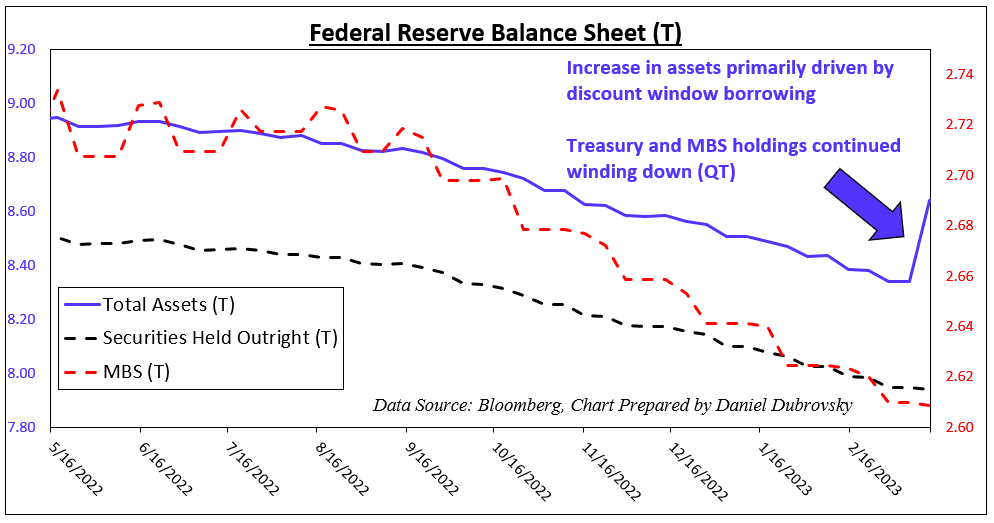As the Fed intervenes in order to prevent a crisis in the US banking system, analysts answer whether the Fed has chosen to pivot from its quantitative tightening measures.
The banking crisis last week in the US pushed Wall Street to the edge giving glimpses of yet another 2008-like financial crisis. However, the Fed and other agencies intervened pumping a fresh $300 billion into the economy and thus increasing its balance sheet.
This has served as a temporary oxygen to the global market as all the top-three US indices gained significantly on Thursday, March 16. This $300 billion came from the Fed’s emergency liquidity facility and shall help the troubled banks to meet their short-term liquidity needs.
The US banks borrowed approximately $164 billion combined from the Federal Reserve. Besides, the Federal regulators and agencies provided an additional $140 billion “to the new bridge banks for Silicon Valley Bank and Signature Bank established by the Federal Deposit Insurance Corp,” reported Reuters.
As a result, the Fed’s total balance sheet swelled once again by $300 billion. These measures lead to the substantial reduction of balance sheet reduction efforts that the Fed was undertaking over the last six months.
Some analysts are, however, happy that the Fed’s intervention has helped to prevent the contagion from spreading to other banks. Thomas Simons, money market economist with investment bank Jefferies said:
The numbers, as we see them right here, are more consistent with the idea that this is just an idiosyncratic issue at a handful of banks. The government’s support efforts appear likely to work and the size of the numbers reported by the Fed Thursday suggest “it’s not like a huge system-wide problem”.
Has the Fed Pivot to Quantitative Easing?
The recent action from the Fed shows that the Fed is recalibrating its efforts of monetary tightening and might seem to pivot once again towards quantitative easing. All eyes are currently on the Fed meeting next week where analysts are expecting a pause in rate hikes or a 25 basis points hike at the max.
However, the current market mayhem hasn’t stopped the European Central Bank from continuing with rate hikes. On Thursday, the ECB announced another 50 basis points hike despite the Credit Suisse crisis unraveling this week.
The US Dollar jumped on Thursday, as the Fed announced its decision to pump $300 billion into the economy. Although the Fed increases its balance sheet, this is no quantitative easing writes Daniel Dubrovsky, senior strategist at Daily FX. He wrote:
“Make no mistake, this is not quantitative easing. On the chart below, you can see that while overall holdings rose, securities held outright (mostly Treasuries) and mortgage-backed securities (MBS) continued shrinking as one would expect under quantitative tightening.”

Courtesy: Daily FX
Bitcoin and Crypto Market Jump
Just as the US equities rallied on Thursday, Bitcoin and the broader cryptocurrency market joined the party. The world’s largest crypto Bitcoin (BTC) is up by 7.39% over the last 24 hours and currently trading at $26,756 and a market cap of $517 billion.
Altcoins too have joined the party with all the top ten altcoins gaining anywhere between 5-10%. The broader crypto market has added more than $70 billion to investors’ wealth.

Bhushan is a FinTech enthusiast and holds a good flair in understanding financial markets. His interest in economics and finance draw his attention towards the new emerging Blockchain Technology and Cryptocurrency markets. He is continuously in a learning process and keeps himself motivated by sharing his acquired knowledge. In free time he reads thriller fictions novels and sometimes explore his culinary skills.
Subscribe to our telegram channel.
Join
Read More: www.coinspeaker.com









 Bitgert
Bitgert  DIMO
DIMO  Hatom
Hatom  Dream Machine Token
Dream Machine Token  PLAY
PLAY  Dimitra
Dimitra  MCOIN
MCOIN  MATH
MATH  PIXL
PIXL  ChainSwap
ChainSwap  APX
APX  Urolithin A
Urolithin A  Overnight.fi USD+
Overnight.fi USD+  Mountain Protocol USD
Mountain Protocol USD  Avalanche Bridged USDC (Avalanche)
Avalanche Bridged USDC (Avalanche)  Sidus
Sidus  MANEKI
MANEKI  Henlo
Henlo  Sovrun
Sovrun  Spectre AI
Spectre AI  CHEQD Network
CHEQD Network  Wanchain
Wanchain  Mainframe
Mainframe  DeGate
DeGate  Tribal Token
Tribal Token  lmeow
lmeow  Reef
Reef  Clore.ai
Clore.ai  SX Network
SX Network  Sturdy
Sturdy  Wrapped Centrifuge
Wrapped Centrifuge  Klever
Klever  Pikaboss
Pikaboss  Clash of Lilliput
Clash of Lilliput  Keyboard Cat (Base)
Keyboard Cat (Base)  Houdini Swap
Houdini Swap  Aquarius
Aquarius  Agoric
Agoric  ORIGYN Foundation
ORIGYN Foundation  Verasity
Verasity  Saros
Saros  TANUKI•WISDOM (Runes)
TANUKI•WISDOM (Runes)  GenomesDAO GENOME
GenomesDAO GENOME  Rifampicin
Rifampicin